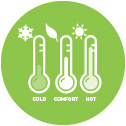Optimise building performance by balancing between heating, cooling, lighting and thermal comfort.
By testing with- and learning from- simulations our modellers can balance heating, cooling, lighting, and thermal comfort, thereby saving electricity over the lifetime of the building and reducing mechanical equipment procurement & maintenance cost.
A climate responsive approach is used during design, and the cost-benefit is evaluated with performance modelling. Future-proof your building with modelling, leaving you less exposed to rising electricity costs and climate change impacts.

Early stage design
Early stage design choices have a vital impact on efficiency and comfort. We offer various lower cost modelling services to guide design choices. See more information here.

Solar Control (Glazing and Shading)
In the African climate, balanced solar control is vital to avoid summer overheating, while still capturing winter sun. This can be tested for using modelling before construction, to help choose the best suited glazing size and types as well as shading measures for your building. Optimised solar control reduces your building’s reliance on expensive HVAC systems, and allows for more frequent use of free, natural ventilation cooling. See case study solar design and daylighting.

Materials
Evaluate the effectiveness of thermal mass, light-weight construction, and insulation. The simulation results will help the choice of a preferred design by showing the effectiveness of passive heating and cooling, thermal responsiveness of light-weight buildings, and energy savings from well-insulated façades.

Thermal Comfort
A person’s sensation of warmth and comfort is influenced not only by indoor air temperature but also other physical parameters such as surface temperature, relative air speed, and humidity. Thermal comfort parameters can be accurately assessed and building controls optimised using our software. See examples – Thermal Comfort Variables and Berekely University Tool.

Natural ventilation
Natural ventilation may provide sufficient cooling for well-designed climate-responsive buildings. This can lead to substantial cost savings, due to smaller HVAC systems, and lower operational costs. Natural ventilation is modelled alongside thermal comfort to evaluate during which times of the year sufficient cooling is possible for mixed-mode designs. Advanced 3D air flow patterns can be evaluated by using computational fluid dynamic (CFD) modelling for detailed designs.

Renewable energy
Our experienced team of engineers can help guide the process of renewable energy and battery system design and offer 3rd party reviews to help integrate and improve the self-reliance from your energy generation system.

HVAC optimisation
We offer hourly energy modelling down to HVAC component level, with trusted advanced Design Builder simulation software. We can model and compare conventional VAV, CAV, and VRF systems, and modern equipment such as radiant heating and cooling systems, heat recovery, ground source heat pumps, and ice storage. We work with the HVAC engineers to get the best result for your building and optimise its operational settings for the lowest maintenance and electricity use.

